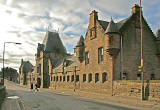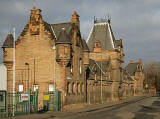Broughton Powderhall
Refuse
Depôt
|
|
Please click a link below, or scroll down this page to read all topics. |
|
|
from |
- Powderhall Refuse Depôt |
|
from |
- Refuse Depot: History - Refuse Depot: Today |
|
from |
- Horse-drawn carts - Electric vans - Strike |
|
from Sybil, Lynn, Massachusetts, USA with reply from |
- The Queen's Lifeguards - Edinburgh Tattoo - In the Streets - Max and Pompei |
|
from |
- Dispatch Rider - Hospital - Garde de Republique Français - Boules - To Edinburgh Castle - French Chateaux |
|
Powderhall Refuse Depot Stables |
|
Sybil, from Lynn, Massachusetts, USA wrote: |
|
"I lived in the Broughton/Belleview area and there were a few old buildings I wish I had pictures of. Do you remember the cleansing dept. on Broughton Rd? It had old stables with overhead hay lofts etc. I wonder if it is still there." Sybil: January 22, 2006 |
|
Powderhall Refuse Depot History |
|||
|
History The cleansing department building that Sybil mentions was built at Boughton Road in 1893, specifically for waste incineration. It was planned that there would be four such buildings, each in a different area of Edinburgh and responsible for incinerating the waste from that area. The building is described in a recent publication as: in
The Scotsman of September 1, 1893 refers to it as being:
The Lord Provost, on an official visit to the building on September 13, 1893, described it as a handsome building, adding:
|
|||
|
Today Now, a large new plant for incinerating the rubbish stands on the land at Powderhall. I suspect that its design would not please the Lord Provost who made the comments above in 1893. However, I checked earlier today and found that the old baronial building still survives, fronting Broughton Road. The stonework was looking a little grubby and the building was partly hidden behind parked cars, but otherwise, it was looking good. - Peter Stubbs: January 23, 200 |
|
Powderhall Refuse Depot Transport |
|
On reading about the history of the Powderhall Refuse Depot, Sybil wrote: |
|
Horse-drawn Carts "If the building dates back to 1893, it would be horse drawn carts that picked up the waste paper, and that's where the horses were stabled." |
|
Electric Vans "It did live up to it's expectations, it was a good looking building, there was never any noise, odor, or smoke. I can remember waste paper being picked up in electric vans. They were really quiet and kind of hummed along." |
|
Strike "Once there was a strike on with the collectors, and all us local kids used to go round the doors asking if people wanted their rubbish taken away. We used old prams, and basically anything on wheels to carry it to "Powderhall" and made ourselves a small fortune from grateful people willing to pay us to do it. We used to separate the stuff ourselves and had stashes of comic books and magazines hidden on a piece of spare ground which belonged to Powderhall Dog racing track. We had a small lending library going and tried to charge but that caused a lot of fights, as you can well imagine. Trying out our entrepreneurial wings." |
|
Sybil: January 22, 2006 |
|
The Queen's Lifeguards Stabled at Powderhall Refuse Depot |
|
Sybil, from Lynn, Massachusetts, USA wrote: |
|
Edinburgh Tattoo "One year when I was young, in the early 50s, I would say, the Queen's Lifeguards were performing in the Edinburgh tattoo and the horses were stabled in the Powderhall Refuse Depot in Broughton Road for the duration. Also the grooms were bunking in the accommodation on the upper floor, and the horse food was stored in the old hay lofts that year.It was a perfect setup. Some of us kids made friends with the grooms, and they would allow us to go in and help to groom the horses, and feed them, and on occasion we were allowed to ride them in the yard to exercise them." |
|
In the Streets "Twice each day the grooms would take all the horses out to be exercised and they rode down Broughton Rd, up Rodney St, into East Claremont St, and back home. All the neighbors would be out to watch. Then in the early evening the soldiers would walk down from the drill hall in East Claremont St where they were barracked, in full dress uniform, breeches tucked into knee length leather boots, loads of gold braid trimming and epaulettes on their jackets, shiny silver helmets sporting huge red fluffy plumes, and spurs and swords jangling. They assembled in the court of Powderhall, then the procession rode along MacDonald Road, up Leith Walk, on to Leith Street and into the Bridges to the High St and the castle esplanade. After their performance the whole thing happened again in reverse. It was a wonderful spectacle which I will never forget." |
|
Max and Pompei "I made friends with a groom called Max. He looked after Pompei, the drum horse. That animal knew he was magnificent, the way he marched in time to the cadence of the drums. He should have been used for dressage. On the last day, Max trimmed a few hairs from Pompei's tail and tied them round my wrist as a bracelet present from Pompei. I felt so special and was a bit upset when they had to leave." |
|
Alex Dow, Fife, Scotland wrote: "Pompey was the Drum Horse from 1938 to 1953. I believe his successor was a St Cuthbert's milk horse that the Queen spotted in the High Street one summer, resulting in his being "called up" into the Life Guards? St Cuthbert's later was the only Co-op ("The Store"), that had a Royal Warrant, for saddlery, harnesses and coachwork repairs?" |
|
Yes, St Cuthbert's Coop restored many Royal Coaches at their works at Fountainbridge, and later near Angle Park Terrace. They also maintained the horse-drawn carts that were used for the delivery of milk in Edinburgh until the 1990s. This was one of the businesses that I visited, several times, when I was photographing people at work in Edinburgh in the 1990s. I have still to add photos from these visits to the Edinphoto web site. - Peter Stubbs: March 25, 2006 |
|
Sybil: January 22, 2006 |
|
Le Garde de Republique Français Stabled at Powderhall Refuse Depot |
|
Alex Dow, Fife, Scotland wrote: |
|
Dispatch Rider "I have just been noting the various comments about the refuse depot. The vehicles were generally horse-drawn until the 1950s. My uncle David Tant was a Dispatch Rider in the Army at the start of WW2. Early one morning, he was passing the depot on his motorbike with a message, either for Edinburgh Castle or for Leith Fort. He was based in one and going to the other. As he went past, a horse-drawn vehicle was coming out and the horse was startled by the m'bike. It bolted, causing Davie to swerve and scrape along the wall of the Cat & Dog Home on the other side." |
|
Hospital "A gouge was taken out of the wall by either the foot-rest or the handle-bar. He ended up in the Sick Bay of the Castle and was later convalescing in Astley-Ainslie Hospital. I remember the sort of "civilian suit" uniform he had to wear during that period, a very definite blue with white shirt and red tie, very reminiscent of one of Trigger's outfits in "Only Fools and Horses". Our Dandy and Beano comics were in high demand from the English soldiers in the Ward. In the grounds of the depot, near the access to St Marks Park, was the Decontamination Block, for furniture etc to be treated." |
|
Garde de Republique Français "In the the early 1950s*, there was sufficient room in the Refuse stables to accommodate the Mounted Section of "Le Garde de Republique Français". * The year was 1952. Here are links to pages on the Edinburgh Military Tattoo web site that list the overseas participants and the UK participants in the Edinburgh Tattoo, for each year since 1949. Thank you to Alex Dow for finding these links. "I remember practicing our French with the soldiers, and the smell of the Gitanes cigarettes which the soldiers kept offering us." |
|
Boules "In the the early 1950s, there was sufficient room in the Refuse stables to accommodate the Mounted Section of "Le Garde de Republique Français". I remember practicing our French with the soldiers. This was the first time that I saw boules as opposed to bools/bowls, being played. The French soldiers played the game on the rough grass near the Fumigation Building alongside the path from Broughton Road, over the Bailey Bridge to St Marks "park", basically the latter is an infill of ashes etc, covered by top soil. The game of boules was virtually unknown in those days. I remember the clink of the steel balls, the under-hand form of throwing, the relatively short distance compared to bowls (just over the railings on the other side of that path); and also 'les pantalons' of the soldiers." |
|
To Edinburgh Castle "Each evening of a Tattoo performance, the Garde would mount up in its full finery in the depot, then ride up McDonald Road etc to the Castle, with Edinburgh Mounted Police leading. Quite a sight and sound, the jingling of the harnesses, the hooves on the cobbles etc." |
|
French Chateaux "I believe the general appearance of the Depot was based on French chateaux, rather like the Nelson's Printing Works on Dalkeith Road, now occupied by the Scottish Widows building." |
|
Alex Dow, Fife, Scotland: February 7, 2006 |

